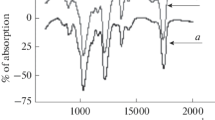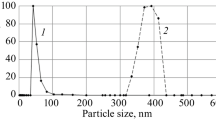The influence of the structure of the surface cellulose acetate layer on the transport characteristics of ultrafiltration composite membranes is considered using the methods of IR spectroscopy and of scanning electron microscopy. The amorphous phase of ultrafiltration cellulose acetate composite membranes is formed at a certain stage of the technological cycle of obtaining a composite membrane. IR spectra are presented where the forms of the absorption bands of valence vibrations of hydroxylic groups at ν = 3339.14–3366.2 cm–1 alter the asymmetry parameter from ~1 for an air-dry sample and to 0.79 for a water-saturated one, which allows the assertion of formation of volumetric supermolecular structure of a cellulose acetate layer of an air-dry sample by two types of hydrogen bonds and dipole–dipole interactions of carbonyl groups. The decrease of the asymmetry parameter to 0.79 of the absorption bands of hydroxylic groups and of the intensity of absorption bands of methyl groups by 2.56, 3.3, and 3.8 times in water saturated samples of membranes occurs because of the destruction of supermolecular structure and reorganization of hydrogen bonds between the active groups of cellulose acetate and molecules of water. The data obtained by the method of scanning electron microscopy allow one to note that the surface layer of ultrafiltration membranes has an asymmetric pore structure. The surface layer of a membrane can be divided into two components: a selectively permeable layer with pores of small size and a pore substrate, in which the pores increase in their diameter as they approach the substrate.
Similar content being viewed by others
References
Zh. Xiaoping, C. Sijing, T. Guochun, and M. Zhenmin, A new poly(2-hydroxy-3-phenoxypropyl) acrylate, 4-hydroxybutyl acrylate, diethyl maleate membrane controlled clonidine linear release in the transdermal drug delivery system, Eur. Polym. J., 43, No. 4, 1588–1594 (2007).
James M. Sloan, Following multicomponent diffusion in polymers by FT-IR-ATR, The Pittsburgh Conference on Analytical Chemistry and Applied Spectroscopy "Science for 21st Century," March 12−17, 2000, New Orleans, LA (2000), p. 1784.
P. M. Pakhomov, M. N. Malanin, and S. D. Khizhnyak, Assessment of the anisotropy of pores in polymer films by the method of IR-spectroscopy, Vysokomol. Soedin., 50, No. 6, 1113–1115 (2008).
A. M. Tsirlin and A. A. Akhremenkov, Boundaries of the realizability region of membrane separation process, J. Eng. Phys. Thermophys., 91, No. 1, 16–25 (2018).
V. N. Zinov’ev, I. V. Kazanin, A. Yu. Pak, A. S. Vereshchagin, V. A. Lebiga, and V. M. Fomin, Permeability of hollow microspherical membranes to helium, J. Eng. Phys. Thermophys., 89, No. 1, 25–37 (2016).
I. Sh. Abdullin, R. G. Ibragimov, O. V. Zaitseva, V. V. Vishnevskii, and N. V. Osipov, Investigation of polyethersulfone membranes, regenerated in NLTP (nonequilibrium low-temperature plasma) by the method of IR-spectroscopy, Vestn. Kazansk. Tekhnol. Univ., 16, No. 21, 168–170 (2013).
O. S. Druzhinina, N. F. Kashapov, A. I. Skorinkin, and D. A. Faizullin, The IR-spectroscopy method in investigation of the interaction of chlorhexidine with lipid membranes, Vestn. Kazansk. Tekhnol. Univ., No. 9, 634–638 (2010).
D. I. Kamalova, IR-Spectroscopy Method of Conformation Probes in Studying the Local Dynamics of Polymers, Doctoral Dissertation (Physics and in Mathematics), Kazansk. Gos. Univ., Kazan (2007).
P. Menut, Y. S. Su, W. Chinpa, C. Pochat-Bohatier, A. Deratani, D. M. Wang, P. Huguet, C. Y. Kuo, J. Y. Lai, and C. Dupuy, A top surface liquid layer during membrane formation using vapor-induced phase separation (VIPS) — Evidence and mechanism of formation, J. Membr. Sci., 310, Nos. 1–2, 278–288 (2008).
V. I. Baikov and N. V. Primak, Permeation rate in selective membrane gas separation, J. Eng. Phys. Thermophys., 81, No. 3, 442–447 (2008).
G. B. Mel’nikova, G. K. Zhavnerko, S. A. Chizhik, and A. V. Bil’dyukevich, Structure and mechanical properties of ultrafiltration membranes modified by Langmuir–Blodgett films, Membrany Membran. Tekhnol., 6, No. 2, 144–151 (2016).
I. V. Vorotyntsev, Physicochemical Foundations of Complex Processes of Separation and Deep Purification of Gases, Author′s Abstract of Doctoral Dissertation (in Engineering), NGTU im. R. E. Alekseeva, Nizhnii Novgorod (2011).
J. Haslam and G. I. Villis, Identification and Analysis of Polymers [in Russian], Khimiya, Moscow (1971).
S. I. Lazarev, Yu. M. Golovin, D. O. Abonosimov, and K. K. Polyansky, An X-ray scattering study of the structure of an MGA-95 composite membrane, Pet. Chem., 54, No. 8, 622–624 (2014).
R. G. Zhbankov, Physics of Cellulose and of Its Derivatives [in Russian], Nauka i Tekhnika, Minsk (1983).
N. G. Bazarnova, E. V. Karpova, and I. B. Katrakov, Methods of Investigating Wood and Its Derivatives: Textbook [in Russian], Izd. Altaisk. Gos. Univ., Barnaul (2002).
C. M. Popescu, G. Singurel, M. C. Popescu, C. Vasile, D. S. Argyropoulos, and S. Willfor, Vibrational spectroscopy and x-ray diffraction methods to establish the differences between hardwood and softwood, Carbohydr. Polym., 77, 851–857 (2009).
O. V. Grechin and P. R. Smirnov, X-ray scattering intensity curves of electrolyte solutions. News of universities, Chem. Chem. Technol., 59, No. 6, 72–77 (2016).
L. Bellamy, The Infrared Spectrum of Complex Molecules [Russian translation], Izd. Inostr. Lit, Moscow (1963).
K. Nakasini, Infrared Spectra of Organic Compounds [Russian translation], Mir, Moscow (1965).
S. P. Papkov, Liquid Crystalline State of Polymers [in Russian], Khimiya, Moscow (1977).
O. A. Osipov, Handbook on Dipole Moments [in Russian], Vysshaya Shkola, Moscow (1971).
Author information
Authors and Affiliations
Corresponding author
Additional information
Translated from Inzhenerno-Fizicheskii Zhurnal, Vol. 94, No. 2, pp. 400–407, March–April, 2021.
Rights and permissions
About this article
Cite this article
Lazarev, S.I., Golovin, Y.M., Khorokhorina, I.V. et al. Influence of the Structure of the Surface Cellulose Acetate Layer on the Transport Characteristics of Ultrafiltration Composite Membranes. J Eng Phys Thermophy 94, 384–391 (2021). https://doi.org/10.1007/s10891-021-02308-7
Received:
Published:
Issue Date:
DOI: https://doi.org/10.1007/s10891-021-02308-7




